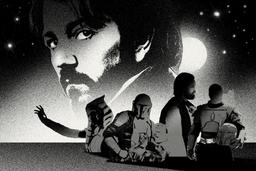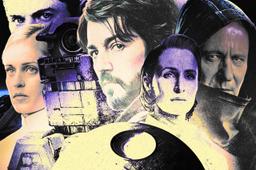
When The Acolyte premiered last year, I was looking forward to a different kind of Star Wars experience: a series set in the unexplored High Republic era featuring new characters and conflicts. The Acolyte was as close to a clean slate as Star Wars could get, and considering it’s been nearly six years since a film last reached theaters, fresh blood was sorely needed for the franchise. Alas, The Acolyte suffered the ignominy of being the first live-action Star Wars show that was outright canceled after its first season.
The Acolyte was far from the finished article, but when it hit, it really hit: The fifth episode, an extended lightsaber battle between a group of Jedi and Manny Jacinto’s biceps, is one of the high marks of the Disney era. The series wasn’t afraid to shake up the status quo, either, challenging preconceptions about the Jedi, introducing a new sect of witchy Force users, killing off major characters, and teasing the appearance of Darth Plagueis—the Sith lord who would go on to take Sheev Palpatine under his wing. Unfortunately, The Acolyte’s willingness to bring new ideas to Star Wars drew the ire of the fandom’s dark side—which also took issue with the show’s diverse ensemble—echoing the backlash to The Last Jedi. Yet, going back to when Darth Vader revealed himself as Luke Skywalker’s father, Star Wars is at its best when the franchise avoids playing it safe in favor of doing something bold.
In that respect, Tony Gilroy’s rebellious little corner of a galaxy far, far away might be the pinnacle of modern Star Wars storytelling. That journey began with the first live-action Star Wars spinoff film, Rogue One (cowritten by Gilroy), which depicted how the Rebel Alliance retrieved plans for the Death Star ahead of the events of A New Hope. Whereas previous movies focused on Jedi, Sith, and the all-important Skywalker lineage, Rogue One was about ordinary individuals who were willing to step up in extraordinary circumstances. The Rebel spy compromising his morals for the greater good; the scientist secretly building a fatal flaw in the Death Star’s designs; the Imperial pilot defecting, at great personal risk, because it’s the right thing to do. There was an edge to Rogue One not seen in other Star Wars projects, epitomized by every principal character dying on-screen and Darth Vader making a memorable cameo in which he slaughters a bunch of hapless Rebels.
While Gareth Edwards directed Rogue One, Gilroy has been credited as saving the film in reshoots, which he said was in “terrible, terrible trouble” before being brought into the fold. There’s no mistaking Gilroy’s imprint on Andor, though. A prequel to Rogue One, the Gilroy-created series follows Diego Luna’s eponymous protagonist as he goes from a small-time thief to a vital cog in the early days of the Rebel Alliance. Like Rogue One, however, Andor is really an ensemble piece, shining a spotlight on the kinds of characters that rarely—if ever—get ample screen time in Star Wars: blue-collar workers, prisoners, Imperial middle management, politicians, a spymaster masquerading as an antiquities dealer.
This grounded approach makes Andor feel genuinely lived-in, wherein every indignity suffered by regular people plants the seeds for rebellion, and Imperial actions are driven by careerists willing to do whatever it takes to rise through the ranks. It’s a side of Star Wars we haven’t seen before, owing as much to sophisticated thrillers like Gilroy’s Michael Clayton as it does to George Lucas’s original films. As a result, Andor achieved a level of acclaim associated with the very best of prestige television: The first season was a mainstay on critics’ year-end lists in 2022—The Ringer included—and was nominated for eight Emmys, including Outstanding Drama Series.
There’s considerable fanfare heading into Andor’s second season, which premieres Tuesday. As the series draws closer to the events of Rogue One, Cassian Andor and the other Rebel heroes must reckon with the moral cost of inciting rebellion—how allowing the Empire to continue committing unspeakable atrocities while the galaxy is watching can be just as important to the cause as fighting back. (To paraphrase Luthen Rael’s iconic monologue in Season 1: The characters must be willing to burn their decency for someone else’s future.) This season also hammers home the idea that the people who start a revolution may not live to see it come to fruition, which is particularly affecting knowing how Cassian’s journey will end. Meanwhile, the Empire continues to tighten its grip, surveilling senators, planting propaganda, and implementing draconian laws, all while constructing the Death Star in secret. In the original trilogy, we accepted the Empire as the franchise’s big bad at face value; time and again, Andor lets us see how that kind of evil permeates through apathy and complacency.
All in all, Andor remains exceptional television, but it won’t be on our screens much longer. While Gilroy originally envisioned making five seasons of the show, Andor will wrap up this year by condensing its title character’s journey with multiple time jumps. (This is also why Andor is being released in four three-episode blocks this season: Each one represents a different year of the characters’ lives.) On the one hand, it’s refreshing when a series avoids overstaying its welcome and goes out on a high note. On the other hand, Andor’s imminent conclusion accelerates a big-picture concern for Star Wars: What the hell comes next?
In terms of television, the only non-animated project remaining on the docket is the second season of Ahsoka, release date TBD. There’s a little more clarity on the feature film front: The Mandalorian & Grogu, a continuation of the live-action series, will hit theaters in 2026. Other movies are in various stages of development—including a James Mangold–directed prequel about the origins of the Force, as well as a Rey stand-alone film that takes place after The Rise of Skywalker—but considering how many Star Wars projects have fizzled out over the years, I honestly won’t believe any of these are happening until a trailer drops. All of this uncertainty adds to the feeling that Disney doesn’t quite know what to do with Star Wars, damaging the brand in the process. Even Skeleton Crew, a charming throwback to Amblin-style adventure films like The Goonies, never got the viewership it deserved.
This makes Andor a breath of fresh air, but as much as I’m celebrating the series, I also worry it could be the last hurrah for a once-great franchise. Some may think the cure to Disney’s Star Wars woes is making more projects that are similar to Andor, but we don’t need all of them to hit this kind of mature, grounded tone. (This is supposed to be a family-friendly franchise, even if the animated shows have no shortage of traumatizing moments.) Instead, the lesson of Andor’s success should be that Star Wars is a big tent capable of integrating different stories, genres, characters, and filmmaking styles. The galaxy is a vast place, after all.
Sadly, with some notable exceptions, Star Wars has lately been giving fans more of the same, if not outright backtracking on its own ideas. Perhaps Disney shouldn’t shoulder all the blame for the franchise’s unwillingness to experiment, especially when some corners of the internet vehemently protest whenever Star Wars tries something new. Still, if Andor has proved anything, it’s that meaningful change always carries risk, but it’s better than sitting back and doing nothing. For Star Wars to thrive, it must evolve—the question is whether a notoriously risk-averse studio like Disney will ever allow it to do so. It might be a pipe dream, but rebellions are built on hope.





